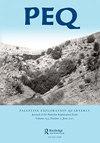Something borrowed, something new? Semitic loanwords and transcriptions in the Greek epigraphy of Palestine and Arabia
IF 0.6
2区 历史学
0 ARCHAEOLOGY
引用次数: 0
Abstract
ABSTRACT This article considers Semitic loanwords and transcriptions in the Greek epigraphy of the southern Levant, roughly corresponding to the Roman provinces of Judaea–Palaestina and Arabia, through three case studies entailing Hebrew, Aramaic, and Arabic as source languages. The texts are a bilingual Hebrew–Greek ossuary inscription from a burial cave in Jerusalem; a Greek mosaic inscription from the cathedral church of Madaba; and a bilingual Greek–Old Arabic rock-cut graffito from Wadi Salma in north-west Arabia. This consideration complements a similar survey for Syria and Phoenicia by J.-B. Yon and reinforces his conclusion of a connection between loanwords and epichoric religious traditions. It also provides a counterpoint to the more recent study of J. Price and S. Naeh, who associate transcription with ‘marginality’ and ‘liminality’; the cases assembled here show that, at least for the inscribers, the practice was instead centrally integrated with religion and culture.借的东西,新的东西?巴勒斯坦和阿拉伯希腊金石学中的闪米特借词和抄本
摘要本文通过以希伯来语、阿拉姆语和阿拉伯语为源语言的三个案例研究,认为黎凡特南部希腊金石学中的闪米特外来词和转录本大致对应于罗马的犹太行省——Palaestina和Arabia。这些文字是来自耶路撒冷一个埋葬洞穴的希伯来语-希腊语双语骨库铭文;来自马达巴大教堂的希腊马赛克铭文;以及来自阿拉伯西北部Wadi Salma的希腊语-古阿拉伯语岩石切割涂鸦。这一考虑补充了J.-B.Yon对叙利亚和腓尼基的类似调查,并强化了他关于外来语和史诗宗教传统之间联系的结论。这也为J.Price和S.Naeh最近的研究提供了一个对照,他们将转录与“边缘性”和“界限性”联系起来;这里汇集的案例表明,至少对神学家来说,这种做法反而与宗教和文化集中融合在一起。
本文章由计算机程序翻译,如有差异,请以英文原文为准。
求助全文
约1分钟内获得全文
求助全文

 求助内容:
求助内容: 应助结果提醒方式:
应助结果提醒方式:


